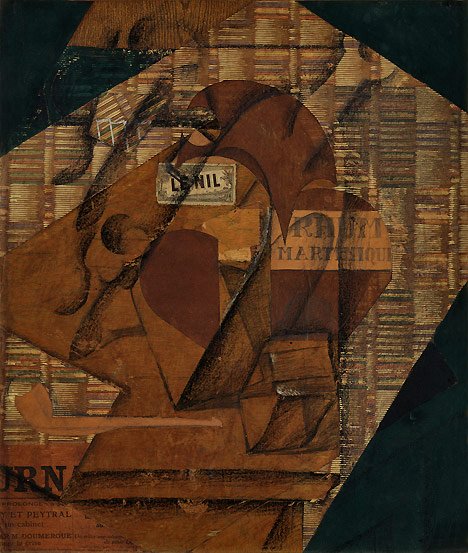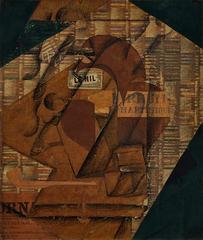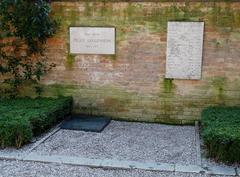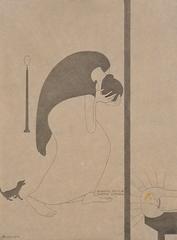
Palazzo Venier dei Leoni: Visiting Hours, Tickets, and In-Depth Guide to Venice’s Historic Art Landmark
Date: 15/06/2025
Introduction
Palazzo Venier dei Leoni, a striking presence along Venice’s Grand Canal in the Dorsoduro district, epitomizes the intersection of Venetian history, neoclassical architecture, and cutting-edge modern art. Commissioned by the noble Venier family in the mid-18th century and designed by architect Lorenzo Boschetti, the palace is as famous for its unfinished, single-story profile as for its transformation into the home of the Peggy Guggenheim Collection—one of the world’s most significant museums of 20th-century art.
This comprehensive guide explores Palazzo Venier dei Leoni’s architectural story, its resonance in Venetian heritage, practical visitor details—including opening hours and ticketing—accessibility, and tips for exploring Venice’s rich cultural fabric. Whether your interests lie in history, art, or architecture, this guide will help you make the most of your visit to this extraordinary site.
(Guggenheim Venice, Wikipedia)
Table of Contents
- Origins and Architectural Ambitions
- The Unfinished Palace: Causes and Consequences
- The Name: “Dei Leoni”
- The Venier Family and Historical Context
- From Private Residence to Artistic Landmark
- The Peggy Guggenheim Collection
- Architectural Features and Museum Layout
- Visitor Information: Hours, Tickets, Accessibility
- Travel Tips and Nearby Attractions
- Frequently Asked Questions (FAQ)
- Visuals and Media Recommendations
- Conclusion and Call to Action
- References
Origins and Architectural Ambitions
Commissioned in 1749 by the illustrious Venier family, Palazzo Venier dei Leoni was conceived as a grand neoclassical palace that would rival the city’s finest. Architect Lorenzo Boschetti, also known for the façade of the Church of San Barnaba, envisioned a monumental five-story residence, as shown in engravings by Giorgio Fossati and a wooden model by Domenico Rizzi (preserved at the Museo Correr). The original design incorporated Palladian and Longhenian elements, featuring a stately Istrian stone façade, classical columns, and ornamental details that spoke to the Veniers’ prominence and aspirations.
(Guggenheim Venice, Christie’s)
The Unfinished Palace: Causes and Consequences
Despite the grand vision, construction halted abruptly around 1751, leaving only the ground floor completed. Historians attribute this to a combination of the Venier family’s financial setbacks and the broader economic decline of 18th-century Venice. The result is an unusually low, elongated palace—sometimes called “maifinìo” (“never finished”)—that stands out among the towering silhouettes of neighboring palazzi. This architectural restraint creates a unique “pause” along the canal, underscoring both the ambition and vulnerability of Venice’s patricians.
(Wikipedia, Guggenheim Venice)
The Name: “Dei Leoni”
The palazzo’s evocative name, “dei Leoni,” is most likely derived from the lion-head mascarons carved in Istrian stone at the base of the façade—symbols echoing Venice’s Lion of Saint Mark. While legend tells of a live lion once kept in the garden, scholarly consensus points to these sculpted lions as the true inspiration.
(Visit Italy)
The Venier Family and Historical Context
The Veniers were among Venice’s most distinguished noble families, with a lineage tracing back to ancient Rome and a history that includes three Doges and numerous Procurators of St. Mark’s. Sebastiano Venier, famed for his victory at the Battle of Lepanto and subsequent tenure as Doge, embodies the family’s legacy. Palazzo Venier dei Leoni was intended as a monument to this heritage, but its unfinished state became a symbol of shifting fortunes and the decline of Venice’s aristocracy.
(Guggenheim Venice)
From Private Residence to Artistic Landmark
After remaining in the Venier family for over a century, the palazzo passed through several owners, each drawn to its distinctive structure and garden. In 1949, the American art patron Peggy Guggenheim acquired the property, transforming it into both her home and a living museum. Guggenheim’s move marked a pivotal shift, turning a symbol of faded grandeur into an international center of avant-garde art.
(Universes in Universe, Letterstobarbara)
The Peggy Guggenheim Collection
Peggy Guggenheim (1898–1979) was a visionary collector whose friendships with artists like Picasso, Pollock, Ernst, and Duchamp shaped one of the 20th century’s most important art collections. After settling in Venice, she opened her home to visitors by appointment. Following her death, the palazzo and its contents were bequeathed to the Solomon R. Guggenheim Foundation, opening to the public in 1980 as the Peggy Guggenheim Collection. Today, it attracts nearly half a million visitors annually and is second in popularity only to the Doge’s Palace in Venice.
(Wikipedia, Museumsexplorer.com, Letterstobarbara)
Architectural Features and Museum Layout
Façade and Exterior
- Neoclassical Elements: Istrian stone, harmonious proportions, and restrained ornamentation characterize the façade.
- Lion-Head Mascarons: Distinctive sculpted lions at water level.
- Unfinished Profile: Single-story height, unfinished cornices, and wide, horizontal layout create a unique canal-side silhouette.
(Venice Travel Tips)
Interior and Gardens
- Galleries: The single-level plan ensures accessibility and natural light, with rooms opening onto the canal and a central sculpture garden.
- Nasher Sculpture Garden: Features modern sculptures by artists such as Henry Moore and Alberto Giacometti, offering a peaceful retreat and a unique interaction between art, architecture, and nature.
(Musei Venezia)
Adaptation for Museum Use
- Minimal structural intervention preserves the palazzo’s historical integrity while incorporating climate control and security for the art collection.
Visitor Information: Hours, Tickets, Accessibility
Opening Hours
- Open: Daily from 10:00 AM to 6:00 PM (last entry at 5:30 PM), closed Tuesdays and December 25.
(Peggy Guggenheim Collection - Visit)
Tickets and Prices
- Adults: €16
- Seniors (over 65): €14
- Students (under 26): €9
- Children (under 10): Free
- Discounts: Available for Venice residents and university students
- Advance Booking: Strongly recommended, especially during peak seasons
(Peggy Guggenheim Collection - Tickets)
Accessibility
- The museum is wheelchair accessible, with ramps, elevators, and accessible restrooms. Guide dogs are welcome.
Guided Tours and Audio Guides
- Guided tours (available in multiple languages) and audio guides can be booked in advance to enrich your visit.
(Peggy Guggenheim Collection - Guided Tours)
Visitor Facilities
- Cloakroom: Large bags and umbrellas must be checked; suitcases not permitted.
- Restrooms: Accessible facilities near the entrance.
- Shop: Open during museum hours, offering books, posters, and design objects.
- Café: Light refreshments available in the garden café overlooking the canal.
Photography
- Non-flash photography is permitted for personal use; flash, tripods, and selfie sticks are not allowed.
Travel Tips and Nearby Attractions
- Getting There: Easily reached by Vaporetto (waterbus) via Accademia or Salute stops, or on foot from Piazza San Marco (approx. 15 minutes).
- Best Times to Visit: Weekday mornings and late afternoons for a quieter experience; avoid weekends and major holidays when crowds peak.
- Nearby Sites: Combine your visit with the Gallerie dell’Accademia, Punta della Dogana, and Basilica di Santa Maria della Salute; explore the artisan shops and cafés of the Dorsoduro neighborhood.
- Duration: Allow 1.5–2 hours for a standard visit; more if you join a guided tour or explore special exhibitions.
Frequently Asked Questions (FAQ)
Q: Where can I buy tickets for the Peggy Guggenheim Collection?
A: Purchase online through the official website or at the museum entrance.
Q: Is the museum accessible for people with disabilities?
A: Yes, the museum is fully accessible, with ramps, elevators, and accessible restrooms.
Q: Are guided tours available?
A: Yes, guided tours and audio guides are available in multiple languages for deeper engagement.
Q: Can I take photos inside the museum?
A: Yes, non-flash photography is allowed for personal use except in some special exhibitions.
Q: Is there a café onsite?
A: Yes, a garden café offers snacks and refreshments with views of the sculpture garden and canal.
Q: How much time should I allow for my visit?
A: Plan for at least 1.5–2 hours; more if attending tours or special events.
Visuals and Media Recommendations
- Explore virtual tours for a preview of the galleries and sculpture garden.
- Visit the museum’s media gallery for high-quality images and interactive maps.
- Use alt text such as “Palazzo Venier dei Leoni façade on the Grand Canal” or “Nasher Sculpture Garden at Peggy Guggenheim Collection” for accessibility and SEO.
Conclusion and Call to Action
Palazzo Venier dei Leoni, home to the Peggy Guggenheim Collection, offers an unparalleled blend of architectural intrigue and cultural innovation. From its unfinished 18th-century façade adorned with lion heads to its status as a modern art haven, the palazzo captures the spirit of Venice—bridging past and present, tradition and creativity.
To maximize your experience:
- Book tickets online in advance
- Consider a guided tour or audio guide
- Visit nearby cultural attractions in Dorsoduro
- Download the Audiala app for personalized travel tips and interactive maps
Immerse yourself in this unique Venetian treasure—where history, art, and architecture converge on the Grand Canal.
References
- Palazzo Venier dei Leoni: History, Visiting Information, and Insider Tips for Tourists in Venice, 2025, Guggenheim Venice (Guggenheim Venice)
- Palazzo Venier dei Leoni, 2025, Wikipedia (Wikipedia)
- Palazzo Venier dei Leoni: Visiting Hours, Tickets, and Architectural Highlights of a Venice Historical Site, 2025, Musei Venezia (Musei Venezia)
- Peggy Guggenheim Collection Venice: Visiting Hours, Tickets, and Must-See Artworks, 2025, museumsexplorer.com (museumsexplorer.com)
- Visitor Information and Practical Tips, 2025, Peggy Guggenheim Collection Official Website (Peggy Guggenheim Collection - Visit)
- Peggy Guggenheim Collection, 2025, Universes in Universe (Universes in Universe)
- Peggy Guggenheim Collection Venice: An Outrageous Woman and Her Outrageously Good Art, 2025, The Geographical Cure (The Geographical Cure)
- Peggy Guggenheim Collection Venice How to Visit It, 2025, Visit Italy (Visit Italy)
















































































































